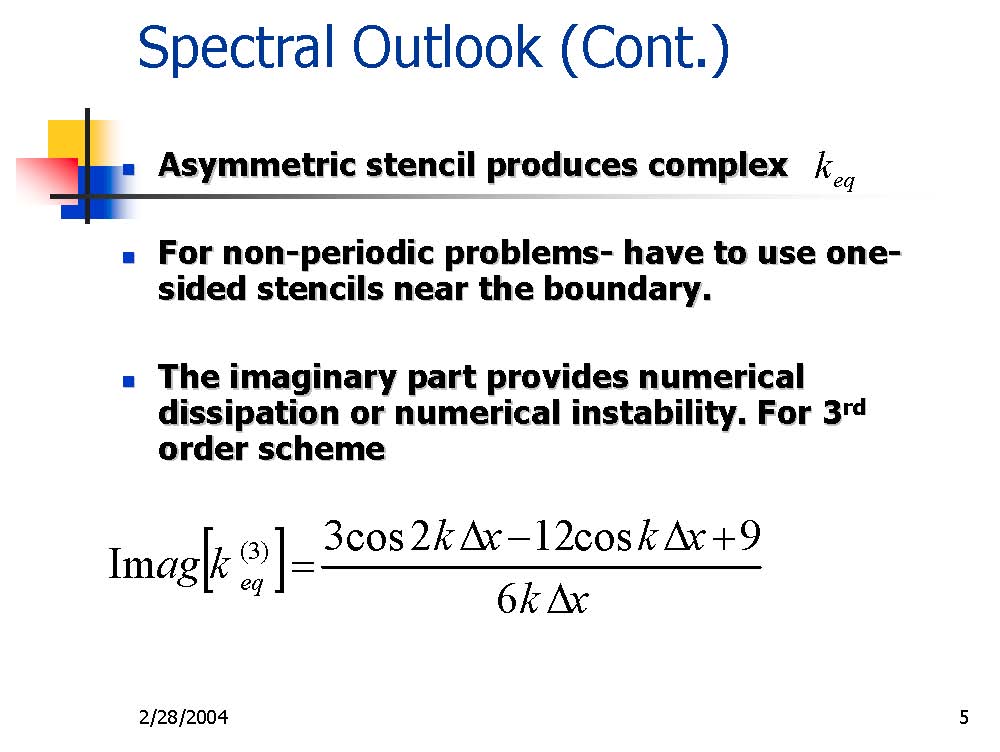Numerical Methods- DNS & LES
The major thrust of all activity is geared towards developing high accuracy computing methods for DNS and LES using finite difference and finite volume methods. Initially, the focus was on developing higher order explicit upwind methods for computing unsteady flows. After 2001, major developments have been towards high accuracy compact schemes.
Higher Order Explicit Upwinding Methods: In the first phase, during 1988- 2000, the activities were focused on developing and using explicit higher order upwinding schemes for solving unsteady flow problems. Some representative works were reported in:
- 1. Sengupta & Sengupta (1994) solved the bluff-body flow past a circular cylinder using a 3rd order upwind scheme. Spectral analysis of the scheme was presented to show the spectral accuracy and numerical dissipation of the scheme. A brief introduction to spectral analysis is provided here below that enabled us to view explicit schemes.
Details of the spectral method of analysis as developed under Prof. Sengupta’s guidance at IIT Kanpur is now available in the book:
Foundation of Computational Fluid Dynamics: Tapan Kumar Sengupta, Universities Press, Hyderabad (India), 2004.
- 2. In Sengupta & Nair (1997) flow past elliptic cylinder was studied using 3rd and 5th order upwind schemes. Some of the properties of explicit schemes were compared in this paper.
The numerical aspect of work on explicit upwinding schemes was summarized in Sengupta and Nair (Upwind schemes and large eddy simulation- IJNMF vol. 31, pp. 879-889 (1999)), where the connection between higher order upwind schemes was established with LES.
High Accuracy Compact Schemes :
In 2001, Prof. Sengupta and his associates started working in the area of compact difference schemes. A host of new schemes have been developed and used for solving flow problems. In developing new schemes and their interpretation, once again the spectral framework is adopted and a general methodology is presented for all discrete computational techniques. While the full description can be obtained from the book (Fundamentals of CFD- T.K. Sengupta (2004)) or in: Analysis of central and upwind compact schemes- Sengupta, Ganeriwal and De (JCP, vol. 192(2), pp. 677-694 (2003)). A brief description of this follows:
Spectral Analysis of CD SchemesSpectral Analysis of CD Schemes: : Spectral AccuracySpectral AccuracyNumerical DissipationNumerical DissipationDRP PropertyDRP Property
Some representative new schemes are reported in Sengupta et al. (JCP, vol. 192 (2), pp 677-694 (2003)) and in: Navier-Stokes solution by new compact scheme for incompressible flows- Sengupta, Guntaka and Dey (Jour. Sci. Comput., vol. 21(3), pp 269- 283 (2004)).
Typical results of such an analysis are shown below. In the following, the Haras- Ta'asan scheme is from (JCP, 114, 265) and Z-scheme is from (JCP, 144, 662) Also, the OUCS schemes have been developed by us and as referred to above:
All the schemes introduced by us are STABLE GLOBALLY as compared to the other schemes cited- due to improved boundary closure schemes. These new schemes also have more spectral resolution. However, in DNS and LES it is equally important to ensure that the used numerical schemes preserves the physical dispersion relation. For the new introduced schemes, this property is also taken care off. Once again, a global analysis tool is developed to study this property for all discrete computational techniques.














